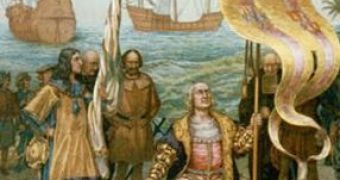The first European settlement in the New World was La Isabela, founded during Columbus's second expedition to the Americas in 1494 on the northern coast of today's Dominican Republic (eastern part of the Haiti island, Caribbean).
The roughly 1500 colonists expected to get rich in a short period of time by mining for precious metals, but instead they faced hurricanes, hunger, diseases and unfriendly locals.
In 1496, Columbus went back to Spain and the few remaining colonists left the town in 1498.
During the late 1980s and early 1990s, at the site of the ancient town were found roughly 100 pounds of galena, a silver-bearing lead ore, and over 200 pounds of metallurgical slag.
Initially, this led to the idea that they found silver in the area, but a new investigation proves that this silver was not mined in the Haiti Island. "The ore that researchers excavated from the settlement, La Isabela, came from Spain," said Alyson Thibodeau, associate professor of anthropology and a geosciences graduate student at University of Arizona in Tucson. "What appeared to be the earliest evidence of European finds of precious metals in the New World turned out not to be that at all," said David J. Killick, an archaeometallurgist at UA.
It resulted that the colonists brought the Spanish ore to Haiti to use for comparison when exploiting the new ore deposits they expected to find. By 1497, finding no gold or silver, those people desperately tried to save something valuable from the failed settlement, so that they extracted silver from the Spanish galena. "This part of the story of Columbus's failed settlement is one that couldn't be found in the historical documents. We could never have figured this out without applying the techniques of physical sciences to the archaeological artifacts." said Thibodeau,
"The slag turned out to be lead silicate -- the end product of an improvised smelting process. Lead silicate is good for nothing. Other smelting processes used at the time could recapture the ore's lead so it could be used for musket balls and as cladding for ships", said Killick. "Why waste the lead? Normally, they would smelt the galena to lead", he added.
A microscopical analysis detected silver spots, so the colonists might have tried to get silver from the galena by removing all the lead.
The researchers were on the point of believing this was the first proof of Europeans prospecting for silver in the New World, especially because Columbus, during his second voyage, had passed through islands where galena is known to naturally occur. "It was puzzling that the documents made no mention of finding such ore. Maybe it didn't seem to be enough metal to mention or maybe some members of the expedition were trying to hide the discovery", said Killick.
After that, the team employed isotope analysis, which is like a geological fingerprint, showing where a mineral originates from: the results were clear, the galena was from Spain.
The expedition's documents reveal they brought lead and the researchers correlated this with a common practice of the time: galena was mixed with ground ores to assess if they had gold or silver. The gold or silver presence was assessed in the new ore probes by comparing it with galena containing a known, small quantity of silver; that was the main purpose of the expedition.

 14 DAY TRIAL //
14 DAY TRIAL //